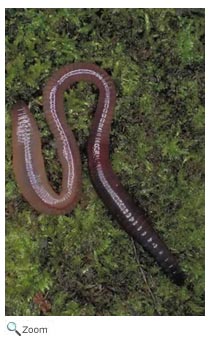 There are about 15,000 species in this phylum. The phylum includes
earthworms, leeches, and marine worms known as polychaetes. Species in this phylum have metameric bodies. There are about 15,000 species in this phylum. The phylum includes
earthworms, leeches, and marine worms known as polychaetes. Species in this phylum have metameric bodies.
Segmented Bodies
Metameric bodies are divided into segments called annuli.
The annuli are covered in tiny hairs called setae. Setae help the worms move. Each segment contains parts of
the organism's excretory, circulatory, reproductive, and nervous system! The head and the rear of the body is not segmented.
In One End and Out the Other
The digestive system of species in this phylum runs the length of the body.
Food is taken in at one end of the body and expelled at the other end.
Moving Along
Annelids have two sets of muscles that help them move. One set expands their body and the other set contracts it. By alternating these muscles, annelids can move their bodies!
Digging in the Dirt
Species in this phylum are found in all parts of the world. Some live in water, and some live on land.
Burrowing annelids, like the earthworm, play an important role in helping organic matter decompose.
Earthworms eat dead plants and animals. When they eat, they also take in soil and tiny pebbles.
Earthworms take in nutrients from microorganisms in the material they ingest. They then excrete wastes in the form of casts. Casts are rich in nutrients like nitrogen, phosphorus, and potash. In addition to breaking down organic materials and adding nutrients to the soil, earthworms also help loosen the soil so air can circulate. This helps plants grow. |
 There are about 15,000 species in this phylum. The phylum includes
earthworms, leeches, and marine worms known as polychaetes. Species in this phylum have metameric bodies.
There are about 15,000 species in this phylum. The phylum includes
earthworms, leeches, and marine worms known as polychaetes. Species in this phylum have metameric bodies. 